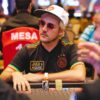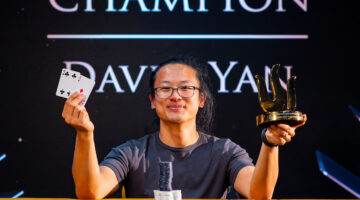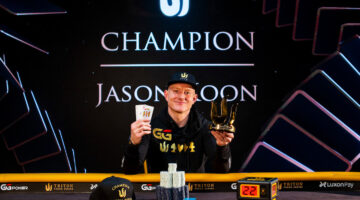At the end of Level 12, with just over 350 players remaining on Day 2 in the $10,500 WPT EveryOne for One Drop, the floor announced that Action Clocks would be used at all tables at the beginning of Level 13.
Players are permitted 15 seconds to make initial decisions pre-flop while they get 30 seconds to use for each decision afterward. Players are also given 10 time extension chips, with additional timebanks awarded at the three-table redraw.

With the top 210 players making a min-cash of $17,500, the bubble can be painfully long (and expensive), with many poker rooms and poker tours (such as the WSOP) waiting until just before the bubble to go hand-for-hand. Frustrating and unnecessary tanking as the bubble approaches, in many cases, is a +EV “strategy”, which can see action grind to a halt and tournament directors running all over the floor to attend to several clock calls.
However, the World Poker Tour have been at the forefront of tanking prevention and are the industry leader when it comes to using the official Action Clock.
Let’s take a look at the history of the Action Clock.
Who created the Action Clock?

Gardens Casino tournament manager Cavin Quintanilla, CEO of Gaming Advancement Marketing Entertainment, LLC (G.A.M.E.), was growing tired of witnessing the abundance of time-wasting on his own floor and wanted to do something about it.
“After working in the gaming industry for years, I noticed that there were two overwhelming flaws with live poker – bad beats and stalling,” Quintanilla told the WPT back in 2021.
Quintanilla then teamed up with long-time poker fan and recreational player Kent McLaren, who had been the official scorer of the NBA’s Los Angeles Clippers from 1984 to 2014. Together, in 2015, they started to come up with ways to speed up the game of poker and founded Protection Poker.
Working with Mike Sexton to find a solution

Online shot clocks were already a thing but to figure out how much time would be acceptable in a live venue, Quintanilla and McLaren had to go to the experts. They both figured out pretty quickly that it wouldn’t just have to be an acceptable format for the players, they needed to create a way that would be simple and seamless enough for all dealers to use without affecting the flow of play.
The two would turn to long-time WPT commentator, WSOP bracelet winner, and Poker Hall of Famer Mike Sexton for advice at the 2015 American Poker Conference. With his advice, the tablet concept was born, making it super-easy for dealers to touch and go while also creating some excitement for the viewing public as everyone would know if a player was running out of precious time. The use of the Action Clock would also create fewer moments of confrontation, as calling the clock on a player is still viewed by many as an unfriendly action.
Sexton’s influence would be monumental in bringing the Action Clock to the WPT. After a few trial runs at smaller venues, much of the poker world finally got what they wanted as the Action Clock debuted at the $15,000 WPT Tournament of Champions at the Seminole Hard Rock.
Initial criticism

Leading the way to criticize the Action Clock was Jordan Cristos, who won the 2013 WPT Legends of Poker Main Event title. Cristos is and has always been an unapologetic tanker and vocal opponent of shot clocks, claiming that the +EV advantage is worth taking up everyone’s time.
Cristos would get in a heated Twitter dispute with both Daniel Negreanu and Mike Sexton, leading Cristos to claim he’d unnecessarily make full use of his time for each and every decision as an act of protest.
There was also the thought that dealers and floor staff would naturally slow down dealing with shot clock issues. Many also hypothesized that amateurs may not play due to having to make all their decisions quickly, while others believed that players wouldn’t have the required time or time bank chips necessary to make all their important decisions correctly.
To that point, basic shot clocks that were little more than bulky stopwatches had been used in super high-rollers and at Aussie Millions, with great success. In fact, Aussie Millions even promoted the use of shot clocks in tournaments by putting the words ‘Shot Clock’ directly into the tournament title (ie. $50,000 No Limit Holdem Shot Clock Six Max).
WPT World Championship success

Following the 2015 WSOP Main Event final table, where Zvi Stern and Pierre Neuville took outrageous amounts of time to make basic decisions, the large majority of the poker-viewing public called for change.
As previously mentioned, Daniel Negreanu was extremely in favor of a shot clock and wanted players like Jordan Cristos to be stopped in their tracks.
The WPT World Championship was there to be the game-changer and eventually, the day arrived. Despite all the initial fears and question marks, the event went on without a hitch and was an incredible success on multiple levels.
“By Day 2, it was as if it was always there,” Quintanilla said. “And the info we received from the WPT was it was their fastest final table ever. It saved them time and money on production.”
After playing with the Action Clock for the first time, five-time WSOP bracelet winner and Poker Hall of Famer Eli Elezra called for the tool to be used everywhere.
The Action Clock also received massive praise from poker pros all around the world.
“I love the Action Clock,” said two-time WPT champion Antonio Esfandiari. “It makes poker more fun.”
“I love it, to be honest,” German Dietrich Fast said, despite having admitted to being a slower player.
“Love these clocks,” said WPT champion Tyler Patterson. “I’m not sure how it affects the action yet, but the mechanics for the dealers look real easy, big [numbers], good sound.”
The Action Clock even received praise from WPT Executive Tour Director Matt Savage, who admitted that he was initially against the idea.
Phil Laak called the move “monumental” for poker and even those who didn’t care for the Action Clock at the time praised the World Poker Tour for being innovative and willing to take risks.
Soon after, the Action Clock was utilized at the $25K High Roller event in the PokerStars Players Championship (PSPC) in the Bahamas and at the Pokerstars Championship Macau, both in the HKD$400,000 Super High Roller and the HKD$103,000 High Roller.
The Action Clock and other shot clocks are now pretty commonplace in a large number of poker tournament series all around the world. In fact, in Brazil (where the author plays), every single tournament at virtually every poker room in the country has time banks implemented from Level 1. Maybe one day the WSOP will finally get it together and do the same?



